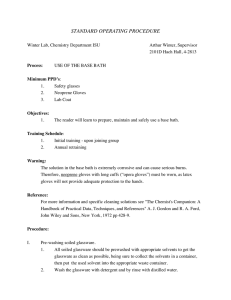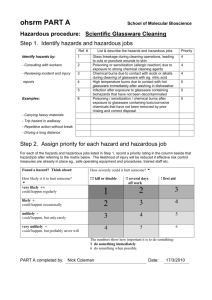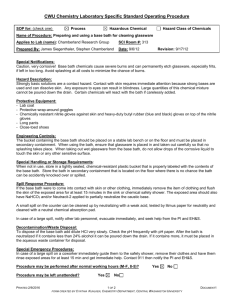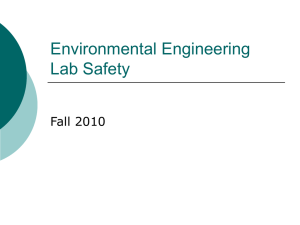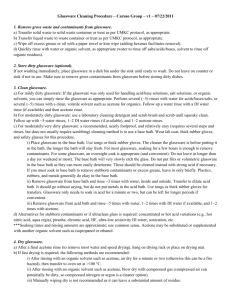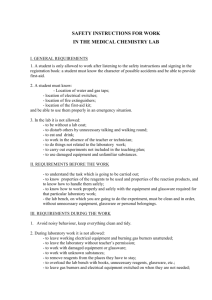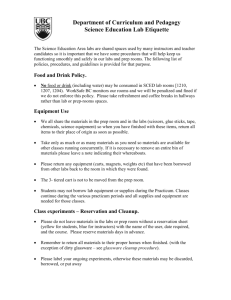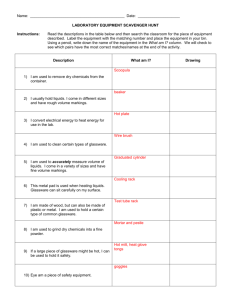Base Bath to Clean Glassware - Environmental Health and Safety at
advertisement
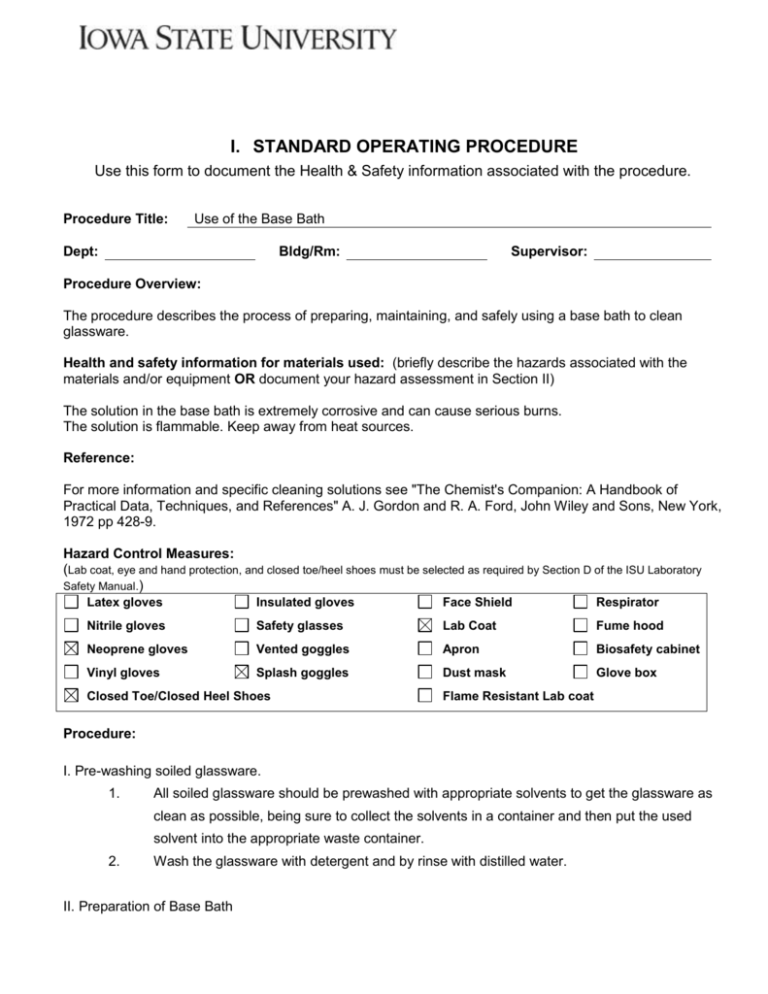
I. STANDARD OPERATING PROCEDURE Use this form to document the Health & Safety information associated with the procedure. Procedure Title: Use of the Base Bath Dept: Bldg/Rm: Supervisor: Procedure Overview: The procedure describes the process of preparing, maintaining, and safely using a base bath to clean glassware. Health and safety information for materials used: (briefly describe the hazards associated with the materials and/or equipment OR document your hazard assessment in Section II) The solution in the base bath is extremely corrosive and can cause serious burns. The solution is flammable. Keep away from heat sources. Reference: For more information and specific cleaning solutions see "The Chemist's Companion: A Handbook of Practical Data, Techniques, and References" A. J. Gordon and R. A. Ford, John Wiley and Sons, New York, 1972 pp 428-9. Hazard Control Measures: (Lab coat, eye and hand protection, and closed toe/heel shoes must be selected as required by Section D of the ISU Laboratory Safety Manual.) Latex gloves Insulated gloves Face Shield Respirator Nitrile gloves Safety glasses Lab Coat Fume hood Neoprene gloves Vented goggles Apron Biosafety cabinet Vinyl gloves Splash goggles Dust mask Glove box Closed Toe/Closed Heel Shoes Flame Resistant Lab coat Procedure: I. Pre-washing soiled glassware. 1. All soiled glassware should be prewashed with appropriate solvents to get the glassware as clean as possible, being sure to collect the solvents in a container and then put the used solvent into the appropriate waste container. 2. Wash the glassware with detergent and by rinse with distilled water. II. Preparation of Base Bath 1. Place approximately 8 liters of isopropanol in a plastic bucket that has a tight fitting lid. 2. To the isopropanol, carefully add about 1 kg potassium hydroxide III. Using the base bath. 1. Before working with the base bath, be sure that your gloves are in good condition. Replace them if you have any doubt as to their condition. 2. While wearing safety goggles and neoprene gloves, glassware that has been pre-washed according to the above procedure is gently lowered into the base bath allowing the solution to completely fill the glassware. 3. Allow the glassware to remain in the solution several hours or overnight. 4. While wearing safety goggles and neoprene gloves, remove glassware from the base bath allowing as much of the solution to drain as is possible. 5. Rinse the alcoholic solution from the glass with tap water. 6. Rinse with distilled water. 7. Rinse with acetone and place on the drying rack. 8. After 15 min. the glassware may be placed in a drying oven. Cautions: 1. Glassware can be etched from prolonged exposure to the basic solution. Quartz glassware is too expensive to routinely expose to this risk. It should not be cleaned with a base bath. 2. Base bath will enlarge the pore size of glass frits and should only be used on fritted glassware as a last resort. Maintenance: Base baths should be disposed of as hazardous waste, through EH&S, and replaced with new base/alcohol solutions as the cleaning ability decreases; normally the base bath is useable for several months. Waste Disposal Procedures: Manage waste as hazardous chemical waste. Contact EH&S for disposal. First Aid Procedures: Eye Contact: Check for and remove any contact lenses. Immediately flush eyes with running water for at least 15 minutes, keeping eyelids open. Cold water may be used. Get medical attention immediately. Finish by rinsing thoroughly with running water to avoid a possible infection. Skin Contact: In case of contact, immediately flush skin with water for at least 15 minutes while removing contaminated clothing and shoes. Get medical attention immediately. Inhalation: If inhaled, remove to fresh air. If not breathing, give artificial respiration. If breathing is difficult, give oxygen. Get medical attention immediately. Ingestion: If swallowed, do not induce vomiting unless directed to do so by medical personnel. Never give anything by mouth to an unconscious person. Loosen tight clothing such as a collar, tie, belt or waistband. Get medical attention immediately. All accidents and injuries occurring at work or in the course of employment must be reported to the employee's supervisor as soon as possible (even if no medical attention is required). http://www.ehs.iastate.edu/occupational/accidents-injuries Spill/Release Containment, Decontamination, and Clean Up Procedures: Use the laboratory spill kit to control the spill. Using Substances Requiring Special Procedures? No X Yes (If Yes; identify authorized personnel, designate a use area and specify specialized safety precautions here. Refer to Section B in the ISU Laboratory Safety Manual for details.) Written By: Date: Approved By: Date: (PI or Lab Supervisor) II. HAZARD ASSESSMENT Use the hierarchy of controls to document the hazards and the corresponding control measure(s) involved in each step of the procedure. Consider elimination or substitution of hazards, if possible. Engineering Control(s): items used to isolate the hazard from the user (i.e. fume hood, biosafety cabinet). Administrative Control(s): policies/programs to limit the exposure to the hazard (i.e. authorizations, designated areas, time restrictions, training). Required PPE: indicate PPE including specific material requirements if applicable (i.e. flame resistant lab coat, type of respirator or cartridge). Hazard Engineering Control(s) III. Administrative Control(s) Required PPE Training Record Use the following table to record the training associated with this Standard Operating Procedure. Print Name Signature Note: Attach to or file with written materials and methods Date
